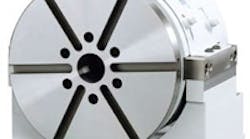It was in the early 90’s when Mike Langlois, owner of Aero Precision Machine, Julian N.C., decided to set up a shop to specialize in closetolerance aerospace parts.
A friend recommended that he consider a colleted-spindle turning machine and suggested that he look at Hardinge (www.hardinge.com) lathes.
Langlois purchased a used Hardinge HNC lathe and began making aircraft landing gear bushings. His wife and two sons joined the business in 1996 that has now grown to 10 employees in about 8,000 square feet of shop space, and still growing.
Aero Precision Machine now produces parts for the aerospace, defense and pharmaceutical industries.
The shop handles mostly smaller parts in diameters up to 10 in., but its sweet spot is making parts in the the 0.75-in. to 2.50-in. range. Over the years Aero Precision Machine has built its entire turning capabilities using Hardinge collet-ready spindle lathes for high-precision turning, including a Quest 10/65 Super- Precision HydroGlide turning center.
“Using a collet, I can spin the part up faster, turn it at high rpm, and the concentricity and the surface finish are better. Plus, the setup is quicker,” Langlois said.
“This was one of the features that sold me on the Direct-Drive Rotary System from Hardinge Workholding. One of the advantages of the indexer is the collet-ready spindle that lets us use our existing supply of collet-type workholding. We didn’t have to buy anything. We use mostly 16C collets in this shop and the DD300 rotary system uses 16C collets,” Langlois said.
The DD300 combines high torque, high speed and high accuracy in one rotary system. With no gears, there is no wear over time. Accuracy of the unit is ±3 arc-sec, with ±2-arcsec repeatability and 0.0002-in. maximum runout.
A wheel-style part, made from 2024 aluminum, is used in the pharmaceutical inspection process. The customer’s part to be inspected is located against each of the six drilled surfaces. Aero Precision Machine turns the outside diameter, faces and cuts off the part on the Hardinge turning lathes. Then the part is slipped on a Sure-Grip expanding collet in the Hardinge DD300 Rotary System for machining on a Bridgeport XR1000. A ball mill produces the twelve outside shapes, then the part is center drilled and the six ports are drilled true to the center position.
Fast, precise positioning is accomplished with the Hardinge gearless, directdrive rotary system with rapid indexing from hole to hole. “We used to run this part on a different brand 5th-axis indexer until we purchased the Hardinge directdrive rotary system, Langlois said.
“We see a 30 percent reduction in part cycle time due to the ultra-fast positioning speed of 1,500 degrees per second, and a cutting speed of 600 degrees per second of the DD300 direct-drive system. We are also seeing more consistent repeatability.”
With the other-brand indexer to make the parts, offset changes had to be made on the machine tool nearly every other part to keep it within tolerance. The part’s pick-up contours have to be held to within 0.001 in. on diameter and at a 60 arc-sec angular position.
“The combination of the Bridgeport XR1000 and Hardinge DD300 rotary system made holding both tolerances as simple as falling off a log. The XR1000 has thermal compensation on the Z axis so holding diameters on parts being processed on a DD300 requires far fewer offset changes. This Direct- Drive Rotary System is a nice asset to our company and fits perfectly in our 16C collet shop,” continued Langlois.
“It has more speed and accuracy than anything I’ve seen on the market. In this era of multitasking machines, and especially for jobs that require a heavy-duty milling spindle, the DD300 could be the device that opens up the frontier of turning on a mill,” Langlois said.








